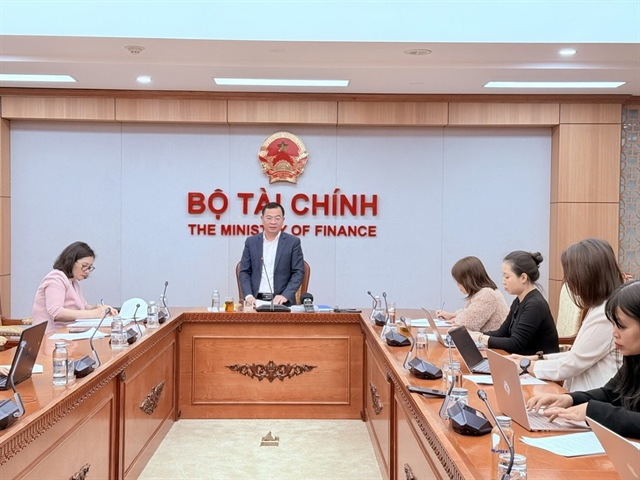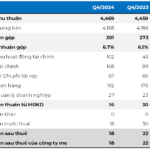This information was shared by Mr. Nguyen Tan Thinh, Director of the Public Property Management Department (Ministry of Finance) at a press briefing on the total inventory of public assets held on March 14.
More than 11,000 underutilized or unused real estate assets
According to Director Nguyen Tan Thinh, before the reorganization of the apparatus, the Ministry of Finance had issued sufficient guiding documents. During the streamlining process, the new units inherited the assets and were responsible for arranging and utilizing them appropriately.
For movable assets, the units need to rearrange and transfer them to the new locations. For immovable assets such as buildings and land, they need to be dealt with according to their actual condition.

Mr. Nguyen Tan Thinh, Director of the Public Property Management Department, informs the results of the public asset inventory. Photo: VGP |
Mr. Thinh added that the Public Property Management Department has proactively reported to the competent authorities for the issuance of legal documents. Specifically, the Government has issued Decree 114/2024/ND-CP and Decree 50/2025/ND-CP (February 28, 2025). These decrees regulate the handling of public assets during the reorganization of the organizational apparatus.
In December 2024, the Ministry of Finance also issued Document No. 13749 guiding the arrangement and handling of public assets during the streamlining of the apparatus. The Ministry of Finance requested agencies and units to inventory, review, and classify assets to prevent losses and ensure their proper management. For instance, in cases of mergers or acquisitions, the assets would be transferred to the managing unit.
Furthermore, the Ministry of Finance will propose certain adjustments to the legal documents on public assets to align with the new organizational model.
The Ministry of Finance closely monitors the progress of the apparatus reorganization and is preparing a report for the competent authorities to approve the organizational schemes, serving as a basis for the rational arrangement and utilization of public assets.
To prevent waste in public asset management, Director Nguyen Tan Thinh stated that the Ministry of Finance has instructed ministries, sectors, and localities to review and report on the status of asset utilization, especially focusing on unused or underutilized real estate assets, such as offices and facilities for socio-economic activities.
From March 11, the Ministry of Finance continued to issue Official Letter No. 2950, requesting ministries, sectors, and localities to accelerate the review and handling of unused, underutilized, or improperly used office premises and facilities for socio-economic activities.
The Ministry of Finance has instructed units to develop plans for handling surplus public assets, regularly update new developments during the apparatus reorganization process, and clearly define the responsibilities of organizations and individuals involved. Notably, the Ministry has also set clear deadlines for implementation and evaluated the reasons for the underutilization of real estate assets to propose appropriate handling measures.
Through the total inventory, the Ministry of Finance reported to the Prime Minister about more than 11,000 unused or underutilized real estate assets. Among these, nearly 3,800 assets have had their handling plans approved by authorized agencies, and over 7,200 assets are awaiting specific plans. Most of these assets belong to educational, healthcare, and cultural institutions due to the merger of communal-level administrative units.
Given this situation, the Ministry of Finance has requested ministries, sectors, and localities to develop and issue specific plans for handling surplus real estate assets and clearly define the responsibilities of each agency and unit. Additionally, the Ministry has also requested regular updates, as the streamlining process is ongoing, which may result in additional surplus public assets.
Several ministries and sectors have not completed the registration of inventory objects
Regarding the inventory of public assets, Mr. Thinh mentioned that the Ministry of Finance required units to complete the registration of inventory objects by February 20. However, as of March 13, nine ministries and central agencies have not fulfilled this requirement.
These include the Office of the National Assembly, the Ministry of Industry and Trade, the Ministry of Transport (merged with the Ministry of Construction), the Ministry of Labor, Invalids, and Social Affairs (merged with the Ministry of Home Affairs and transferred some tasks to other ministries), Vietnam Social Security, the Vietnam General Confederation of Labor, the Vietnam Association of Former Fighters, the Vietnam Union of Friendship Organizations, and the Vietnam Union of Science and Technology Associations.
Additionally, 12 localities, including Hanoi, Can Tho, Binh Duong, Binh Phuoc, Binh Thuan, Dien Bien, Ha Nam, Hau Giang, Kien Giang, Quang Tri, Soc Trang, and Thanh Hoa, have not completed the registration of inventory objects.
Director Nguyen Tan Thinh stated that the Public Property Management Department, in its role as the guiding and synthesizing agency for the total inventory results, has assigned specialized officers to support ministries, sectors, and localities in the implementation process. The Ministry of Finance has also provided timely additional guidance and inspected the preparation and inventory process at several units.
However, many ministries, sectors, and localities are still behind schedule. He emphasized that the deadline for units directly involved in the inventory to complete their work is March 31. With limited time remaining, localities need to identify the causes of delays and implement concrete solutions; otherwise, the risk of missing the deadline is very high.
The Ministry of Finance requested ministries, central agencies, and People’s Committees of provinces and cities to review and reorganize the Steering Committees for inventory, while also instructing units undergoing organizational apparatus rearrangement to expedite the total inventory process. Tasks related to the total inventory need to be promptly handed over to the new agencies and units after the reorganization of the apparatus.
MINH TRÚC
– 19:10 14/03/2025
The New Consolidated Ministry of Finance Slashes 3,600 Redundancies
The newly merged Ministry, which includes the Vietnam Social Security, will see a reduction of approximately 3,600 administrative units, a significant 37.7% decrease from its current size.
The Art of Fiscal Management: 5 Ways to Reorganize and Optimize Public Housing and Land Assets
The Ministry of Finance is seeking feedback on a draft decree regulating the rearrangement and disposal of public assets, specifically focusing on houses and land. In this draft, the Ministry proposes five distinct forms of rearranging and managing these assets, which are currently held by various agencies, organizations, and units.
Uniting the Ministries of Construction and Transportation: One Team, No ‘Us and Them’ Mentality
The consolidation proposal is based on the principle of treating the Ministry of Construction and the Ministry of Transport as one entity, without distinguishing between “us and them”. This approach allows for an honest evaluation of overlapping functions and tasks, as well as identifying areas of interconnection and cohesion.
Supplementing VEC’s Charter Capital: What Did Deputy Prime Minister Ho Duc Phoc Have to Say?
On the afternoon of December 10th, at the Government Headquarters, Deputy Prime Minister Ho Duc Phoc had a working session with the Vietnam Expressway Corporation (VEC), the State Capital Management Committee, and relevant ministries and sectors. The discussion focused on two key agenda items: exploring options to supplement VEC’s chartered capital and determining the timeline for repaying the principal and interest of VEC’s government-guaranteed bonds.





















